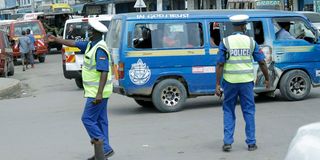What is the sole duty of a traffic officer?

Traffic police officers control the flow along Kenyatta Avenue in Mombasa in this picture taken on December 24, 2021.
What you need to know:
- The judgment is whether the fault is almost certain to cause an accident.
- Any fault of that nature warrants more than a ticket or an on-the-spot fine.
When a traffic police is trained and assigned to duty, they enter a world of two million vehicles, each with 1,000 rules to obey.
That is an enforcement menu of billions of options, so the boss officers must give the newcomers some guidelines on what to prioritise.
They might start with: “If you see a pick-up with a 15mm machine gun mounted in the back, randomly shooting pedestrians, or equipped with a rocket propelled grenade launcher blowing holes in the sides of buildings, these require your attention and intervention more urgently than a broken tail light.”
Other examples might be slightly less stark – like a container lorry with broken turnbuckles so its 30-tonne load is likely to slew sideways or fall off; or 28 people having a nyama choma party on the roof of a moving minibus.
These things are more important than the date on the driver’s licence, or even a bald tyre.
But all these examples establish a first principle: that the absolute priority is to protect road users from “real and present danger”; a high and imminent risk of death, extensive damage or serious public disorder (which is what disruption to flow causes).
The question is not whether any defect in vehicle condition or driver conduct “could” hurt someone else.
Driver conduct
Virtually every breach has that potential, and even a car and driver that are compliant in every way can have an accident.
The judgment is whether the fault is “almost certain” to cause an accident “in the very near future.”
And any fault of that nature warrants more than a ticket or, er, an on-the-spot “fine” and “carry on”.
Not until this level of danger has been effectively addressed should even one moment of any officer’s time be devoted to anything less crucial. This priority briefing is surely a no-brainer, and it gives the traffic officers plenty to do.
Next, surely, in our hyper-congested circumstances, would come a vehicle in poor condition or driver conduct which obstructs optimum traffic flow.
If traffic officers prioritised that, there wouldn’t be any officers with a minute to spare on anything else.
Why is that truck climbing that steep hill at 20 kph, followed by a line of 30 swifer vehicles?
Address things like that and traffic would move a whole lot more swiftly and smoothly… and more safely.
Disrupting traffic flow
Among other things, this would ensure the compliance of all speed bumps…or their immediate removal.
Law enforcement officers should know that, and that it affects every vehicle on every road every day, and profoundly affects traffic flow.
How many non-legal speed bumps have the police reported?
Prosecution for obstructing or disrupting flow should not only apply to drivers. Enforcement should pay equal attention to all road users, and also to road construction, maintenance and road signage teams.
Why should they be any less liable for their culpability? And who better to spot (and act on) their mistakes than policemen posted on the road everywhere, every day.
These are easy calls. The more challenging task comes at the next level of “technical offences”.
Which of those should be the highest priority, and why? Is there a current policy guideline on this and what is it? And why?
Minor traffic offences
Whatever the answer, any choice will come under Section 117 of the Traffic Act for “minor offences”, for which no vehicle should ever be impounded, no driver arrested, and no on-the-spot fine or bond imposed above the legally proscribed maximum.
These are also laws, and they are being broken thousands of times a day. And not only by motorists.
Everyone understands that traffic officers (on foot) have an almost impossible task trying to control two million objects mostly out of their view and moving faster than they can.
Everyone realises most of their “just checking” tasks could be conducted more safely, swiftly and efficiently for all in car parks. Why don’t they do that?
Everyone would like them to remain on roadside duty, too. But with a different task list: to be near enough to be helpful, however, wherever and whenever needed. Utumishi kwa wote.
The essence of flow and safety are mutal respect and partnership, not punishment and revenue collection.





